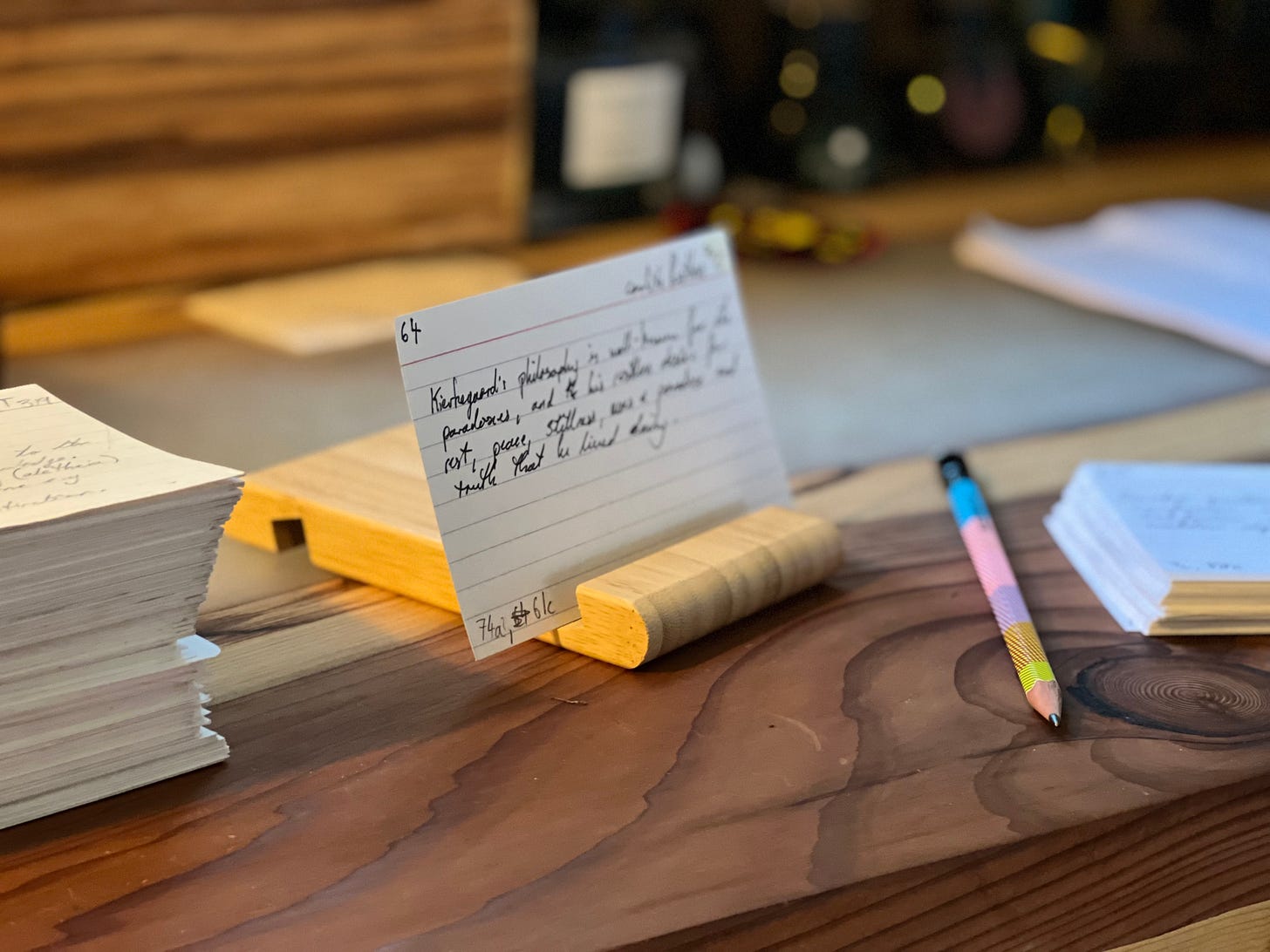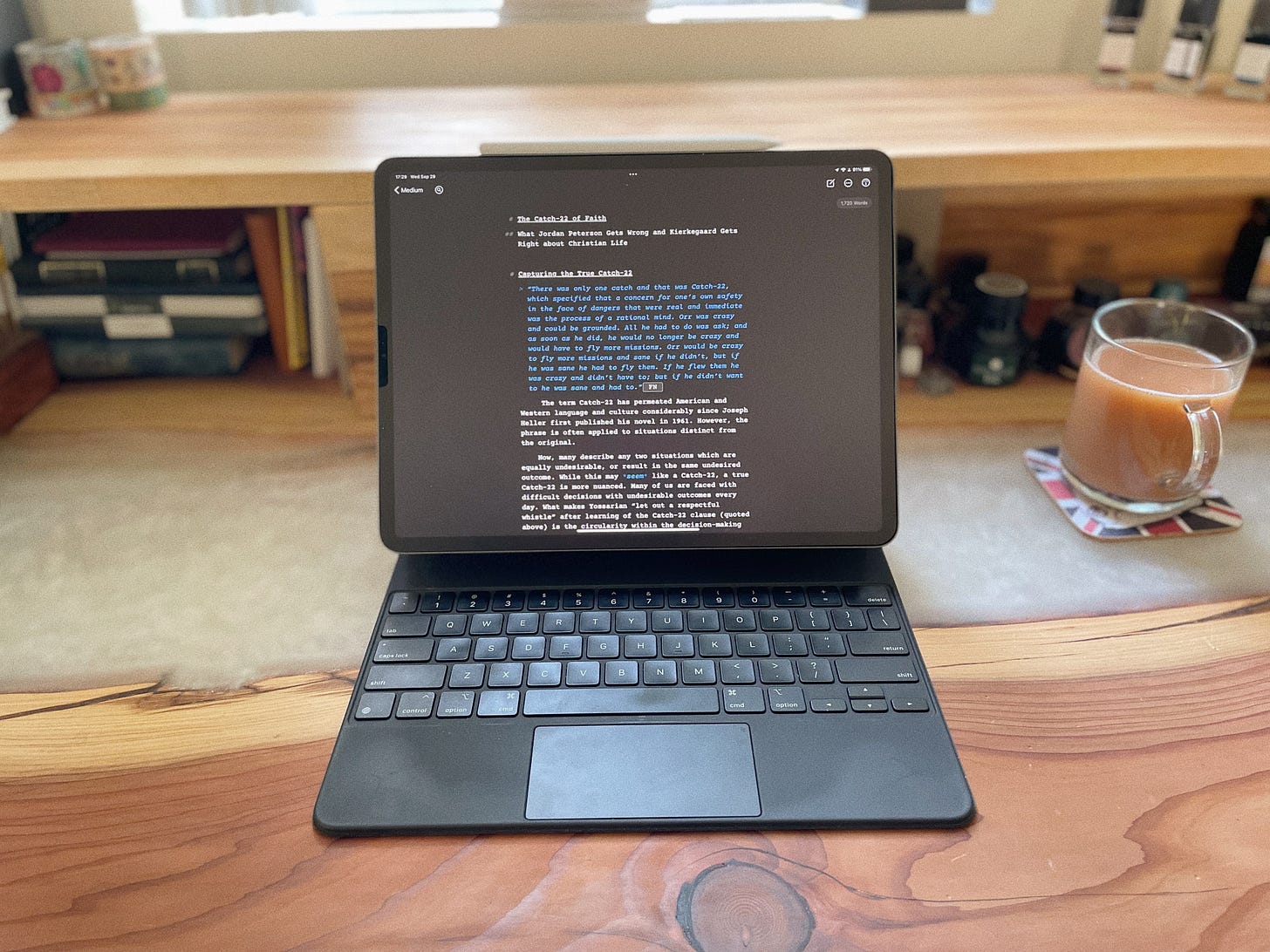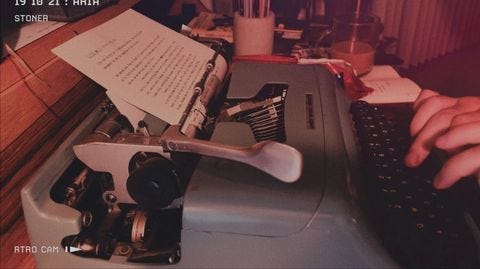In the Fall of 2020, I started a Zettelkasten.
I was in my final semester of law school, and I had taken on a research project looking at the law’s regulatory response to technology through the lens of Martin Heidegger.
You may have heard of a Zettelkasten. It goes by a few different names now. Slip-box. Second brain. Apps like Obsidian and RoamResearch are the digital front-runners for creating a system of networked thought that can function as a Zettelkasten.
And this Zettelkasten that I made kind of changed my life. It was my intellectual conversation partner. Something I could approach, spend some time with, and connect otherwise isolated ideas together into a synthesis that felt novel, tangible, and completely mine. It gave me the tools to have original thoughts.
I started out with some notecards and wrote down various ideas from my research, and connected them using alphanumeric identifiers (e.g. 1a, 3b, 4a1e7). I could not quite believe the value I received from this notecard system. So of course, I continued using it long after my research project had ended and my paper was written. (It was, I think, the best research paper of my academic career. Good to go out on a high, I suppose. I graduated a week after the paper was due.)
As I’ve mentioned, many others have taken this idea and ran with it, discovering and creating various digital software to help anyone create their own Zettelkasten. However, I’ve always made a point of using a physical, paper Zettelkasten made of real notecards.
After all, this is how Niklas Luhmann used his, and he is essentially the 20th-Century inspiration for all the hullabaloo now. (His technique was the subject of Sönke Ahren’s How to Take Smart Notes.1 Ahrens actually recommends using a digital Zettelkasten. Features like search, in particular, make a digital Zettelkasten much more convenient than a paper one. Luhmann was simply constrained by the technology at the time, Ahrens argues.
I’m not so sure.
Luhmann described his slip-box as a “conversation partner.”2 His Zettelkasten was a means of thinking in and of itself. He said that “underlying the filing technique is the experience that without writing, there is no thinking.”3 I don’t think this would have been possible in a digital Zettelkasten for him, even if the option was available.
There is a certain something that occurs when handwriting your ideas, rather than copying and pasting or automatically workflow-ing them into Obsidian. Rewriting what is already written trains yourself to identify patterns, frames, and connections between texts. By rewriting the idea, you place the idea in a different context (outside of its original text), and truthfully translate the original meaning so that you can refer back to it later as an atomic stand-alone idea.
The reliance, especially, on artificial intelligence or algorithmic discovery might feel more efficient, since you’re letting the computer do the work for you. But that is precisely the work you should be doing. By letting the computer do the work, by preferring that, you are making a value statement about yourself. You are saying “my ability to think is lesser than this piece of code written by someone else. This product of someone else’s technical coding knowledge can think better than I can, a fully fledged human being capable of art, peace, critical thinking, and love.” I would even make the argument that the more time we spend with our technology and the various algorithms vying for our attention and purportedly doing work on our behalf, the more we feel forced to think like the algorithm. As James Bridle says, in the “age of algorithmic discovery, even if you’re human you have to end up impersonating the machine.”4
Another reason I prefer physical, paper Zettelkasten to any digital alternatives is the ability to focus on the task at hand. As Richard Polt, author of The Typewriter Revolution, recognizes, one of the “major problems for writers is that the machine we use to write is connected to the biggest engine of distraction ever invented.”5 And anyone who has tried to cultivate a writing habit will know that having to write on a computer, laptop, or iPad that we use for almost everything else as well certainly doesn't help one focus exclusively on writing. The temptation is simply too strong. That temptation is eradicated with a physical Zettelkasten. Both the ability to think without the aid of a computer and the ability to remain disconnected from distraction contribute to a sort of revealing.
This revealing is precisely wherein the value lies in any Zettelkasten, but especially in a physical, paper Zettelkasten. Again, Polt notes that there is an (often less-than-flattering) truth revealed in a physically created written word that is “concealed in a spell-checked, grammar-checked, automatically formatted digital text.”6 The typewriter, much like a physical Zettelkasten, "makes concepts into an actual, tangible product that carries with it, through mistakes and anomalies, the event in which it was made."7 When concepts are made tangible, they become something you can work with, play with, and–as Luhmann knew–talk to. And they'll talk right back to you.
I took a sort of hiatus with my Zettelkasten for most of 2022. And a hiatus from writing. But now that I’m trying to write more regularly again, I find myself stuck with a blank page more often than not. But I’ve also been able to cultivate a habit of waking up, regularly, at 6am. This gives me a good hour of time before I have any other obligations. And as I lay in bed last night, I thought about my Zettelkasten. You see, one of the main problems with a physical Zettelkasten is that it takes a lot of time to keep up. The more cards you create, the longer it takes to place them and connect them with the ever-increasing number of cards you already have. This is the primary problem that A.I. solutions attempt to resolve. But this isn’t a problem at all. In fact, it’s the main feature. Polt, ever insightful, has this to say: “When what you’re doing isn’t just a means to an end, you’re in no hurry to get it done.”8 Zettelkasten isn't about efficiency. It's about thinking, and thinking deeply. Thinking creatively. Thinking in ways that haven't been thought before, about things and connections that haven't been made before. There's no hurry, here. Just as you don't hurry through a conversation with an old friend.
And so I took out my Zettelkasten notecards this morning and started thumbing through them. I have a small stack of cards yet to be integrated into the system at all, so I picked a few that seemed especially interesting to me right now, and started looking through my Zettelkasten to see where I might place them, and see which cards might have any connection to them. And this was a frightfully inspiring and fulfilling experience. (In fact, it inspired this post.)
And so I have resolved myself to dedicate some time in my 6am-7am block of free time to have a conversation with an old friend. Because, like any good friendship, the more you put in, the more you get out.
If you want to learn more about how I create and converse with my physical Zettelkasten, you can check out my course on Skillshare.
Ahrens, Sönke. How to Take Smart Notes: One Simple Technique to Boost Writing, Learning and Thinking. CreateSpace, 2017. North Charleston, SC.
Luhmann, Niklas. “Communicating with Slip Boxes: An Empirical Account". Trans. Kuehn, Manfred. luhmann.surge.sh/communicating-with-slip-boxes.
Schmidt, Johannes F.K. “Niklas Luhmann’s Card Index: The Fabrication of Serendipity”. Sociologica, vol. 12, pp. 53-60, 59.
Bridle, James. “Something is wrong on the internet.” Medium, Nov 6, 2017. https://medium.com/@jamesbridle/something-is-wrong-on-the-internet-c39c471271d2.
Polt, Richard F.H. The Typewriter Revolution: A Typist’s Companion for the 21st Century. The Countryman Press, 2015. Woodstock, VT. Kindle ed. loc 2175.
Ibid., at loc. 3233.
Ibid., at loc. 3235.
Ibid., at loc. 69.






Handwriting thoughts is a powerful tool. I started programming last year and my husband’s biggest advice was hand write your ideas and your code first. It’s not just great for your memory, but also a great way to improve on your code.
👍 Love this!